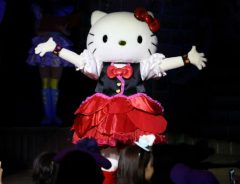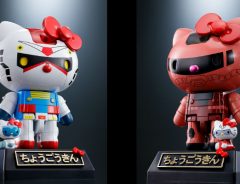
Source: byeangel from Tsingtao, China, CC BY-SA 2.0, via Wikimedia Commons
‘Hello Kitty is not a cat’ and other surprising facts about the world’s favourite feline
- Tags:
- Hello Kitty
Related Article
-

Fans Vote Hello Kitty the Most ‘Kawaii’ Sanrio Character for 2019
-

Japan’s Mascot Celebrities Heading To A Gig, But One Ridiculous Fella Said NO
-

Hello Kitty Is Ready For Adorable Battle With Two Gundam Chogokin Figures
-

Welcome The Reiwa Era With DJ Hello Kitty At LGBT Pride Week’s Rainbow Rooftop Party
-

Sanrio Puroland’s Heartwarming Message from Hello Kitty
-

Japanese organic doughnuts company collab with Hello Kitty to create the cutest Christmas treats


What is the appeal of Hello Kitty? To her fans, she is the embodiment of innocence. As such, you can't help but empathise with her. And that's what she's asking you to do: to be an empathetic person.
Yet Hello Kitty is an ambiguous character. She has hardly any facial features, let alone expressions, and she has no mouth, and is therefore speechless. Her ambiguity is key to her appeal, for it allows the public to imagine her however they like. She's the Mona Lisa of our times.
But Hello Kitty has more of an identity than you might think. According to Christine Yano, a professor at the University of Hawaii who has studied the Hello Kitty phenomenon, she's not a cat at all - she's a little girl (who has a pet cat called Chaami Kitty). She's British - and has several family members named after members of the Royal Family. And she usually wears frilly lace, which her creator associated with British culture.
Yuko Shimizu created Hello Kitty for the merchandising company Sanrio in 1974. She has said that she wanted to create a fictional character that would appeal to young girls. The artist had a lonely childhood and came up with Hello Kitty as a way of "spreading happiness."
Hello Kitty has certainly done that. She is merchandising company Sanrio's most popular - and most profitable - character. Sanrio always had global ambitions for Hello Kitty. The company was convinced that a Japanese fictional character could go toe to toe with Mickey Mouse in the competition for the world's affections. This time, they said to themselves, the cat would beat the mouse.
What is remarkable about Hello Kitty is that Sanrio has managed to spread her brand of happiness round the world with zero marketing. There are no ads for Hello Kitty, and it has never paid for celebrity endorsements or product placements. That hasn't stopped plenty of Hollywood celebrities taking her to heart, including Maria Carey, who was among the first stars to wear Hello Kitty merchandising.
That kind of advertising is priceless and has allowed Sanrio to open Hello Kitty outlets in countries around the world. Such is the ubiquity of her gnomic gaze, she has become a flag bearer for the 'Empire of Cool' that Japan has constructed after its two 'lost decades'. Hello Kitty often comes wrapped in the Japanese flag, putting the soft in the nation's newfound soft power.
Zebrio from Tokyo, Japan, CC BY-SA 2.0, via Wikimedia Commons
Hello Kitty has no enemies in Japan, but plenty of westerners have taken against her. Anti-Hello Kitty feminists argue that her lack of a mouth is offensive, because it suggests that a woman is more appealing when she has no voice (Sanrio Corporation says that Hello Kitty has no mouth because she speaks from her heart, not her mouth).
Some of her detractors have gone further, saying that Hello Kitty embodies the victimhood at the core of the post-war Japanese identity. Victimhood has become a cover for political passivity. In a democracy, political challenges demand the active participation of the citizenry. Rolling over and playing dead just isn't good enough.
Hello Kitty might make a cute kids' toy, but something is very wrong when adults take her to heart, her critics say. She has become a kind of secular icon, uniting Japan in a fluffy, but ultimately empty embrace. This is what academics have called 'the politics of scale'. It's about how powerful, and how much influence you think you have as a political actor.
Many Japanese people, particularly the young, believe they have little political power. Rather than encouraging them to become stronger, kawaii icons like Hello Kitty tell them it's OK to remain powerless. Kawaii celebrates smallness and considers it beautiful. That's all very well if you're celebrating the beauty of a tiny dog, garden or cake, but it makes no sense if you're talking about the third-largest economy in the world, the critics say. Japan is actually very big, and its people very powerful.
anokarina, CC by SA 2.0 | © Flickr.com
So, is Hello Kitty as manipulative as her detractors suggest? Is she an adult pretending to be a child, playing the innocent to avoid having to rise to the challenges of the adult world? Hello Kitty is certainly meek, and this appeals to some anxious adults because she calms them down. She is a soporific talisman, much like the narcotic 'soma' that the dystopian government in Aldous Huxley's novel Brave New World gives to its people to pacify them.
Whatever the source of Hello Kitty's appeal, the Japanese tourist board knows that anime and manga, and kawaii icons in particular, hold great appeal for foreign tourists. As ambassador for Japan's 'kawaii diplomacy,' Hello Kitty is able to create empathy for Japan on the world stage, which makes her a great asset.
The problem is that Hello Kitty is ultimately kitsch, and as such, unreal. Kitsch icons get sympathy by crying, but they're always shedding two kinds of tear: one of genuine sadness, and another because they feel so moved by their ability to feel anything. In other words, only one kitsch tear contains real salt, while the other one is a crocodile tear, shed out of self-pity.
But there is another kind of Hello Kitty fan who takes her to heart precisely because she embodies an extreme form of femininity. Some feminists champion Hello Kitty because, they say, she threatens the patriarchy and the construction of masculinity. This is certainly what students at Harvard University were thinking when they adopted Hello Kitty as their mascot.
It was also what Thai police authorities were thinking in 2007, when they started punishing police officers who showed up late for work by forcing them to wear Hello Kitty armbands. Defending the move, the chief of the Crime Suppression Division in Bangkok said, "Kitty is a cute icon for young girls. It’s not something macho police officers want covering their biceps.”
If you'd like to find out more about the Hello Kitty phenomenon, take a look at this video presentation entitled "Hello Kitty: Japanese Cuteness at Home and Abroad" by Christine Yano.